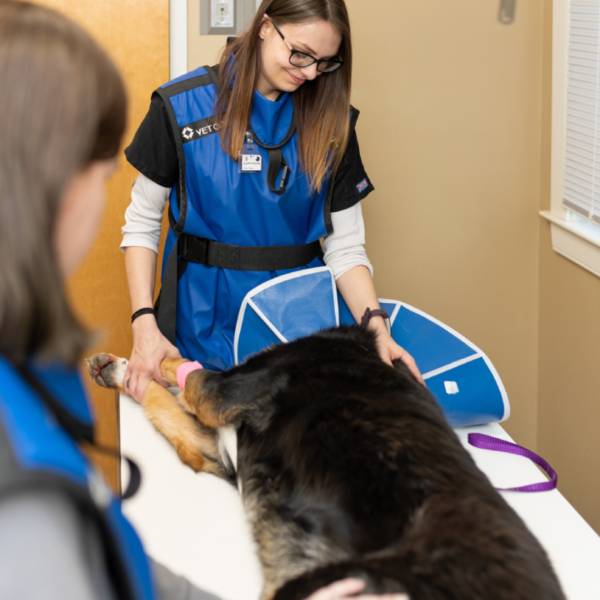Radiology Services at Mount Carmel Animal Hospital
X-rays (radiographs) are a safe, noninvasive diagnostic tool that allows our medical team to evaluate bones, joints, and internal organs with precision. We use this technology to identify a wide range of issues—from fractures and arthritis to foreign body ingestion, bladder stones, and more.
Our digital X-ray system produces high-resolution images in seconds, helping us make confident diagnoses and guide next steps with clarity and care. For most pets, X-rays are quick and painless. If sedation is needed to ensure comfort and safety, we’ll discuss that with you in advance.
What We Can See With X-Rays
Our veterinarians use X-rays to evaluate many health concerns in dogs and cats, including:
- Bone Fractures & Injuries – Detect broken bones, dislocations, or trauma-related damage with speed and accuracy.
Arthritis & Joint Disease – Identify joint degeneration, track the progression of arthritis, and evaluate for conditions like hip or elbow dysplasia. - Tumors & Masses – Reveal abnormal growths in the lungs, bones, or other internal structures—supporting early detection and treatment planning.
- Heart & Lung Conditions – Diagnose heart enlargement, fluid in the lungs, pneumonia, or chest tumors that may be affecting your pet’s breathing.
- Foreign Object Ingestion – If your pet swallows something they shouldn’t, X-rays help us pinpoint the location and determine next steps.
- Dental Disease – Dental X-rays expose hidden issues like tooth root infections, abscesses, or bone loss that can’t be seen during a routine exam.
- Spinal & Nerve Problems – Assess spinal health, investigate causes of back pain or mobility changes, and screen for disc disease or spinal injuries.
- Bladder & Kidney Stones – Identify stones or structural changes in the urinary tract that could be causing pain, blood in the urine, or difficulty urinating.
- Pregnancy Monitoring – Confirm late-stage pregnancy and estimate litter size with clear, accurate fetal imaging.
- Gastrointestinal Concerns – Spot obstructions, blockages, or unusual gas patterns in the stomach and intestines.
When X-Rays Aren’t Enough
While X-rays are a powerful first-line tool, some conditions may require additional diagnostics. Soft tissue structures—like ligaments, organs, or the brain—aren’t always visible on radiographs. Factors such as low body fat or obesity can also affect image clarity.
In these cases, we may recommend:
- Ultrasound, to assess soft tissues like the kidneys, liver, pancreas, or reproductive organs, and to guide needle biopsies for lab testing.
- CT Scans, for highly detailed cross-sectional imaging—especially useful in diagnosing tumors, hidden fractures, or vascular abnormalities.
As always, we’ll walk you through what we see, explain what it means, and guide you in choosing the best next step for your pet.
Sedated X-Rays: When and Why They’re Needed
Most pets do just fine during X-rays without sedation. But in some cases, light sedation may be necessary to keep your pet safe, still, and comfortable—while ensuring we get the clearest images possible.
We’ll always discuss this with you ahead of time and use the lowest effective dose, tailored to your pet’s needs.
Why Sedation May Be Recommended
- Clearer Images – Movement during X-rays—even slight shifting—can blur the image and make it harder to spot problems. Sedation helps your pet stay still, which leads to sharper, more accurate results.
- Less Radiation Exposure – If your pet moves during imaging, we may need to retake the X-ray, increasing exposure for both your pet and our team. Sedation reduces this risk by helping us capture the right image the first time.
- Team & Pet Safety – Some positions required for imaging can be awkward or uncomfortable. If your pet is anxious, injured, or reactive, sedation helps reduce stress and keeps everyone safe—including our staff.
- Pain Management – Holding still in certain positions can be painful for pets with injuries, arthritis, or other painful conditions. Sedation allows us to position your pet gently and comfortably, without added discomfort.
- Specific Imaging Needs – Certain types of X-rays—such as those of the spine, skull, or teeth—require precise positioning and muscle relaxation. In these cases, sedation may be the best way to get a high-quality diagnostic image.
- Stressful Temperament – If your pet is very anxious, fearful, or physically uncooperative, sedation can help create a smoother, less stressful experience for everyone involved.
We understand that sedation can feel like a big step. Our team is here to talk through the risks, benefits, and your pet’s specific needs—so you can make an informed decision with confidence.
Dental X-Rays: Seeing Below the Gumline
Dental radiographs are a vital part of your pet’s oral health care—and one of the most important diagnostic tools we use during professional dental cleanings.
Many dental problems occur beneath the gumline, where they can’t be seen during a routine exam. Digital dental X-rays allow us to assess the health of the entire tooth—including the roots, bone, and surrounding structures—so we can detect hidden issues early and treat them effectively.
Dental X-Rays Help Us Detect:
- Tooth root abscesses or infections
- Fractured or non-visible damaged teeth
- Bone loss from periodontal disease
- Retained baby teeth or unerupted adult teeth
- Tooth resorption (especially common in cats)
- Oral masses or cysts
- Jawbone changes due to trauma or disease
Dental X-rays are performed while your pet is under anesthesia during a professional cleaning. This ensures your pet’s safety and comfort while giving us the clearest possible view—so we can take action right away if treatment is needed.
Learn More About Dental Care at MCAH
At Mount Carmel Animal Hospital, we take a comprehensive approach to your pet’s dental health—from preventive cleanings to surgical extractions when necessary. To learn more about our full range of dental services, visit our Pet Dental Care page.

